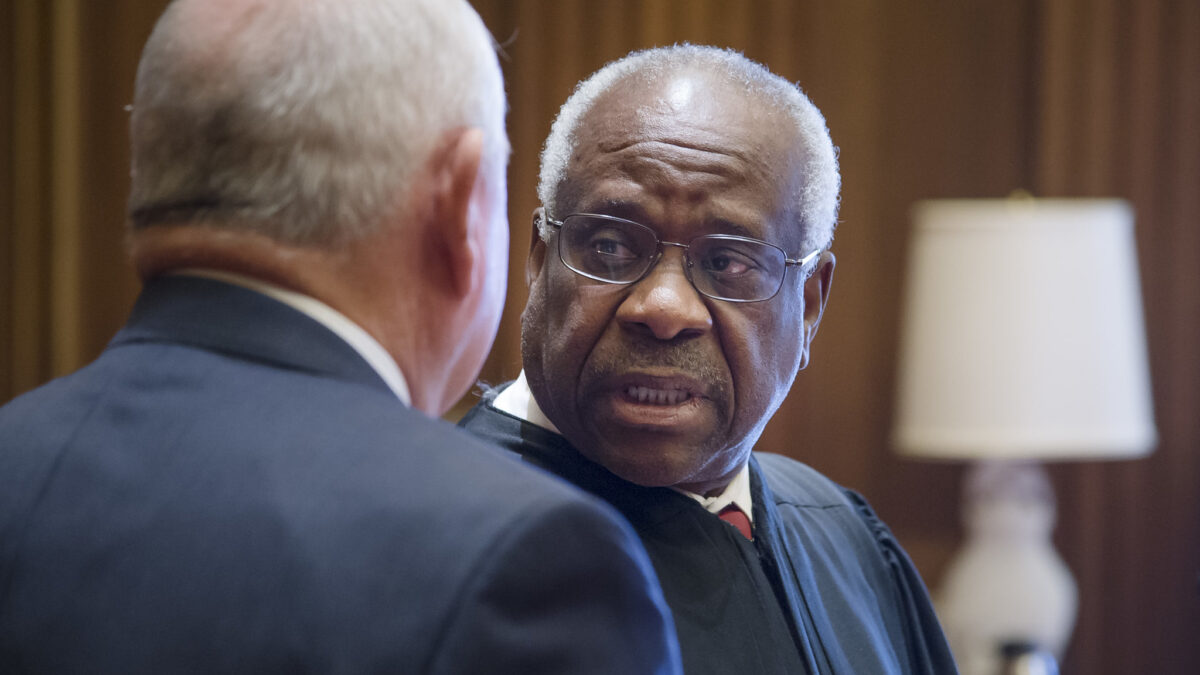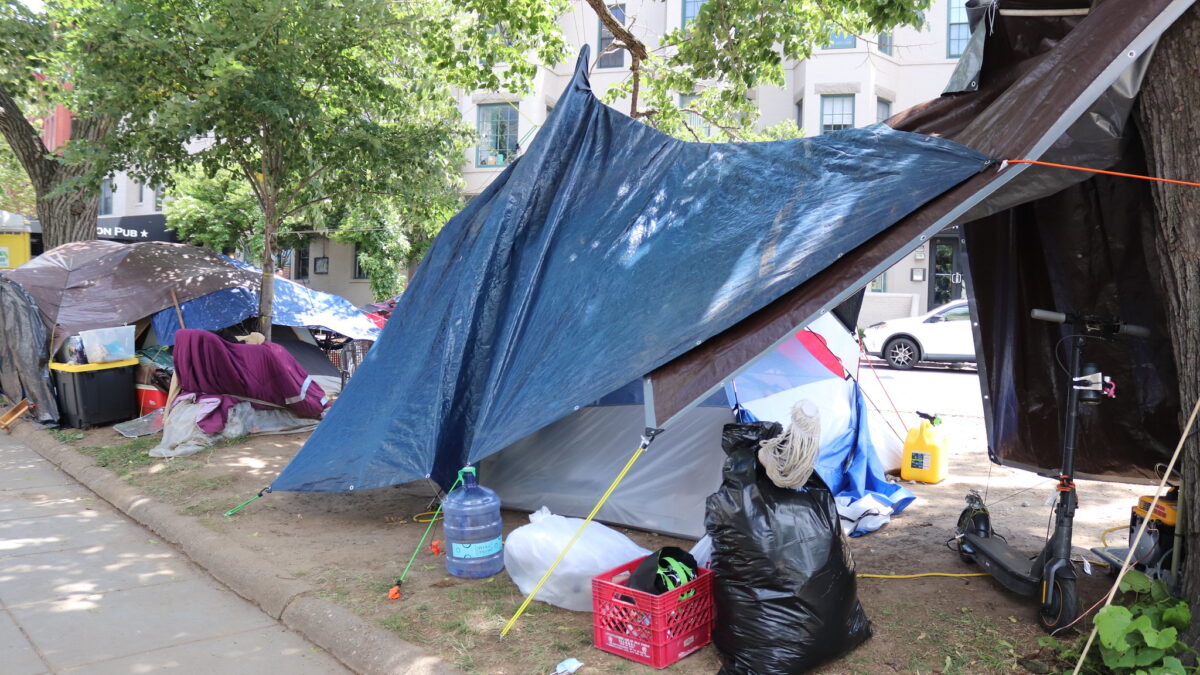The Supreme Court’s Thursday decision in Students for Fair Admissions v. President and Fellows of Harvard College dealt an overdue blow to race-based college admissions, and some of the best punches were thrown by Justice Clarence Thomas in his concurrence.
The court ruled that so-called “affirmative action” at Harvard and the University of North Carolina were in violation of the 14th Amendment and its application via the Civil Rights Act. Policies that discriminate based on race without demonstrating a compelling public interest, the six justices in the majority agreed, are not compatible with our founding principles of equal rights under the law for every American.
In addition to signing on to the majority opinion authored by Chief Justice John Roberts, Thomas wrote a nearly 60-page concurrence to express his horror at the idea of institutionalized racial discrimination in 21st-century America. Here are 15 of his best lines.
1. The best way to fix discrimination is not more discrimination.
[T]he Constitution continues to embody a simple truth: Two discriminatory wrongs cannot make a right.
2. Courts can’t defer to the discriminating body about whether the discrimination is justified.
Universities’ self-proclaimed righteousness does not afford them license to discriminate on the basis of race. In fact, it is error for a court to defer to the views of an alleged discriminator while assessing claims of racial discrimination. … To the extent past is prologue, the university respondents’ histories hardly recommend them as trustworthy arbiters of whether racial discrimination is necessary to achieve educational goals.
3. Using the 14th Amendment to justify discrimination is “self-defeating.”
Without such guardrails, the Fourteenth Amendment would become self-defeating, promising a Nation based on the equality ideal but yielding a quota- and caste-ridden society steeped in race-based discrimination.
4. Racial preferences don’t end inequality, they increase it.
Both experience and logic have vindicated the Constitution’s colorblind rule and confirmed that the universities’ new narrative cannot stand. Despite the Court’s hope in Grutter that universities would voluntarily end their race-conscious programs and further the goal of racial equality, the opposite appears increasingly true. Harvard and UNC now forthrightly state that they racially discriminate when it comes to admitting students, [and] defend that discrimination as good.
5. History indicates we should be distrustful of “experts” who say racial discrimination is “helpful.”
I would have thought that history had by now taught a “greater humility” when attempting to “distinguish good from harmful uses of racial criteria.” From the Black Codes, to discriminatory and destructive social welfare programs, to discrimination by individual government actors, bigotry has reared its ugly head time and again. Anyone who today thinks that some form of racial discrimination will prove “helpful” should thus tread cautiously, lest racial discriminators succeed (as they once did) in using such language to disguise more invidious motives. … [E]xperts and elites have been wrong before — and they may prove to be wrong again.
6. Dealing unfair advantages to one necessarily means dealing unfair disadvantages to another.
[I]t is not even theoretically possible to “help” a certain racial group without causing harm to members of other racial groups[.] … [T]he zero-sum nature of college admissions — where students compete for a finite number of seats in each school’s entering class — aptly demonstrates the point.
7. Young people today are not liable for the sins of generations past.
[U]niversities’ discriminatory policies burden millions of applicants who are not responsible for the racial discrimination that sullied our Nation’s past. … Whatever their skin color, today’s youth simply are not responsible for instituting the segregation of the 20th century, and they do not shoulder the moral debts of their ancestors.
8. A hyperfocus on race communicates to new generations that they should allow racial differences to influence their perception of others.
[S]orting by race … increasingly encourage[s] our Nation’s youth to view racial differences as important and segregation as routine.
9. The end goal of affirmative action is a world in which people are defined by the color of their skin.
What, then, would be the endpoint of these affirmative action policies? Not racial harmony, integration, or equality under the law. Rather, these policies appear to be leading to a world in which everyone is defined by their skin color, demanding ever-increasing entitlements and preferences on that basis. … That is the same naked racism upon which segregation itself was built. Small wonder, then, that these policies are leading to increasing racial polarization and friction.
10. The only solution to racism is true equality under the law.
Racialism simply cannot be undone by different or more racialism. Instead, the solution announced in the second founding is incorporated in our Constitution: that we are all equal, and should be treated equally before the law without regard to our race. Only that promise can allow us to look past our differing skin colors and identities and see each other for what we truly are: individuals with unique thoughts, perspectives, and goals, but with equal dignity and equal rights under the law.
11. People are defined by their choices, not by their circumstances.
Individuals are the sum of their unique experiences, challenges, and accomplishments. What matters is not the barriers they face, but how they choose to confront them. And their race is not to blame for everything — good or bad — that happens in their lives. A contrary, myopic world view based on individuals’ skin color to the total exclusion of their personal choices is nothing short of racial determinism.
12. Elites at institutions such as Harvard should not be picking “racial winners and losers.”
History has taught us to abhor theories that call for elites to pick racial winners and losers in the name of sociological experimentation.
13. Victimization perpetuates itself with no end.
Must others in the future make sacrifices to re-level the playing field for this new phase of racial subordination? And then, out of whose lives should the debt owed to those further victims be repaid? This vision of meeting social racism with government-imposed racism is thus self-defeating, resulting in a never-ending cycle of victimization.
14. Meritocracy is a “great equalizer.”
[M]eritocratic systems have long refuted bigoted misperceptions of what black students can accomplish. … Such scales have always been a great equalizer — offering a metric for achievement that bigotry could not alter. Racial preferences take away this benefit, eliminating the very metric by which those who have the most to prove can clearly demonstrate their accomplishments — both to themselves and to others.
15. To override the Constitution with a racial agenda is to make the same error as segregationists of the past.
The great failure of this country was slavery and its progeny. And, the tragic failure of this Court was its misinterpretation of the Reconstruction Amendments, as Justice Harlan predicted in Plessy. We should not repeat this mistake merely because we think, as our predecessors thought, that the present arrangements are superior to the Constitution.









